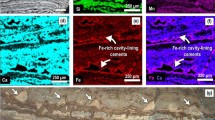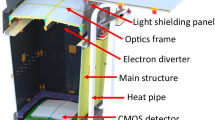Abstract
The Planetary Instrument for X-ray Lithochemistry (PIXL) is a micro-focus X-ray fluorescence spectrometer that is mounted on the robotic arm of NASA’s Perseverance rover. PIXL scans target surfaces with high spacial resolution yielding detailed analyses of rock or soil elemental chemistry. The elemental maps are produced by a narrow 120 μm X-ray beam. These scans are correlated to images captured by PIXL’s Micro Context Camera (MCC) which tie the X-ray measurements to the visual texture and structure of the sample, revealing the distribution and variations of chemical elements within the rock. The PIXL subsystem that determines this correspondence is the Optical Fiducial System (OFS), which is comprised of the MCC, two Structured Light Illuminators (SLI) and a Floodlight Illuminator (FLI). This paper discusses the pre-flight calibration of the OFS, including optical calibration of the MCC, radiometric calibration of the floodlight system and geometric calibration of the structured light illumination beam together with an overall geometric calibration of the OFS and the X-ray beam. Finally, results from the performance verification are presented.
































Similar content being viewed by others
References
Allwood AC, Wade LA, Foote MC, Elam WT, Hurowitz JA, Battel S, et al. (2020) PIXL: planetary instrument for X-ray lithochemistry. Space Sci Rev 216:134. https://doi.org/10.1007/s11214-020-00767-7
Bhartia R, Beegle LW, DeFlores L, Abbey W, Hollis JR, Uckert K, et al. (2021) Perseverance’s Scanning Habitable Environments with Raman and Luminescence for Organics and Chemicals (SHERLOC) investigation. Space Sci Rev 217:58. https://doi.org/10.1007/s11214-021-00812-z
Bouget JY (2003) Camera calibration toolbox for Matlab. Retrieved from http://robots.stanford.edu/cs223b04/JeanYvesCalib/
Brown DC (1966) Decentering distortion of lenses. Photom Eng 32(3):444–462
Brown DC (1971) Lens distortion for close range photogrammetry. Photom Eng 37(8):855–866
Conrady A (1919) Decentering lens system. Mon Not R Astron Soc 79:384–390
Di K, Li R (2004) CAHVOR camera model and its photogrammetric conversion for planetary applications. J Geophys Res 109:E04004
Farley KA, Stack KM, Shuster DL, Horgan BH, Hurowitz JA, Tarnas JD, Simon JI, et al (2022) Aqueously altered igneous rocks sampled on the floor of Jezero crater, Mars. Science 377(6614). https://doi.org/10.1126/science.abo2196
Farley KA, Williford KH, Stack KM, Bhartia R, Chen A, Torre M, et al. (2020) Mars 2020 mission overview. Space Sci Rev 216:142. https://doi.org/10.1007/s11214-020-00762-y
Gennery DB (1992) Least-squares camera calibration including lens distortion and automatic editing of calibration points. In: Workshop on calibration and orientation of cameras in computer vision, XVII congress of the international society of photogrammetry and remote sensing
Grotzinger J, Gupta S, Malin M, Rubin D, Schieber J, Siebach K, et al. (2015) Deposition, exhumation, and paleoclimate of an anchient lake deposit, Gale crater, Mars. Science 373(6551):198–204
Hartley RI (1994) Self-calibration from multiple views with a rotating camera. In: Eklundh JO (ed) Computer Vision – ECCV ’94. Lecture Notes in Computer Science, vol 800. Springer, Berlin, pp 471–478. https://doi.org/10.1007/3-540-57956-7_52
Heirwegh CM, Liu Y, Clark BC, Elam WT, O’Niel LP, Sinclair KP, et al. (2021) Calibrating PIXL for elemental analysis on Mars. In 52nd lunar and planetary science conference
Heirwegh C, Elam W, O’Niel L, Sinclair K, Das A (2022) The focused beam X-ray flourescence elemental quantification software package PIQUANT. Spectrochim Acta, Part B, At Spectrosc 196:106520
Hollis JR, Moore K, Sharma S, Beegle LW, Grotzinger JP, Allwood A, et al. (2022) The power of paired proximity science observation—co-located data from SHERLOC and PIXL on Mars. Icarus 387:115179
Jørgensen PS, Jørgensen JL, Denver T (2004) MicroASC a miniature star tracker. In: Proceedings of the 4S symposium: small satellites, systems and services
Kannala J, Brandt SS (2006) A generic camera model and calibration method for conventional, wide-angle, and fish-eye lenses. IEEE Trans Pattern Anal Mach Intell 28(8):1335–1340. https://doi.org/10.1109/TPAMI.2006.153
Liebe CC, Pedersen DA, Allwood A, Bang A, Bartman S, Benn M, et al (2022) Autonomous sensor system for determining instrument position relative to unknown surfaces utilized on Mars rover. IEEE Sens J 22(19). https://doi.org/10.1109/JSEN.2022.3193912
Liu Y, Tice MM, Schmidt ME, Treiman AH, Kizovski TV, Hurowitz JA, et al. (2022) An olivine cumulate outcrop on the floor of Jezero crater, Mars. Science 377(6614):1513–1519
Pedersen DA, Henneke J, Jørgensen JL, Liu Y, Hurowitz JA, Allwood A (2021) PIXL multispectral capability: false-color imaging and iron-bearing mineral detection. In: 52nd lunar planetary science conference
Pedersen DA, Liebe CC, Jørgensen JL (2019) Structured light system on Mars rover robotic arm instrument. IEEE Trans Aerosp Electron Syst 55(4):1612–1623
Tice M, Hurowitz JA, Allwood AC, Jones MW, Orenstein BJ, Davidoff S, et al. (2022) Alteration history of Séítah formation rocks inferred by PIXL x-ray flourescence, x-ray diffraction, and multi-spectral imaging on Mars. Sci Adv 8(47):eabp9084
Tsai RY (1987) A versatile camera calibration technique for high-accuracy 3D machine vision metrology using off-the-shelf TV cameras and lenses. IEEE J Robot Autom 3(4):323–344
Zhang Z (2000) A flexible new technique for camera calibration. IEEE Trans Pattern Anal Mach Intell 22(11):1330–1334. https://doi.org/10.1109/34.888718
Acknowledgements
The authors greatly appreciate all the PIXL team members contributing with essential support throughout the work in delivering a fully functioning and well performing instrument to Mars. The authors greatly appreciate the independent reviewers for contributing with valuable comments increasing the quality of this manuscript.
Funding
This research was carried out at the Technical University of Denmark and at the Jet Propulsion Laboratory, California Institute of Technology under contract with the National Aeronautics and Space Administration (80NM0018D0004).
Author information
Authors and Affiliations
Corresponding author
Ethics declarations
Competing Interests
The authors have no competing interests to declare that are relevant to the content of this manuscript.
Additional information
Publisher’s Note
Springer Nature remains neutral with regard to jurisdictional claims in published maps and institutional affiliations.
Note by the Editor: This is a Special Communication, linked to the Topical Collection on the Mars 2020 mission published in Space Science Reviews. In addition to invited review papers and topical collections, Space Science Reviews publishes unsolicited Special Communications. These are papers linked to an earlier topical volume/collection, report-type papers, or timely papers dealing with a strong space-science-technology combination (such papers summarize the science and technology of an instrument or mission in one paper).
Rights and permissions
Springer Nature or its licensor (e.g. a society or other partner) holds exclusive rights to this article under a publishing agreement with the author(s) or other rightsholder(s); author self-archiving of the accepted manuscript version of this article is solely governed by the terms of such publishing agreement and applicable law.
About this article
Cite this article
Klevang, D.A., Liebe, C.C., Henneke, J. et al. Pre-flight Geometric and Optical Calibration of the Planetary Instrument for X-ray Lithochemistry (PIXL). Space Sci Rev 219, 11 (2023). https://doi.org/10.1007/s11214-023-00955-1
Received:
Accepted:
Published:
DOI: https://doi.org/10.1007/s11214-023-00955-1




